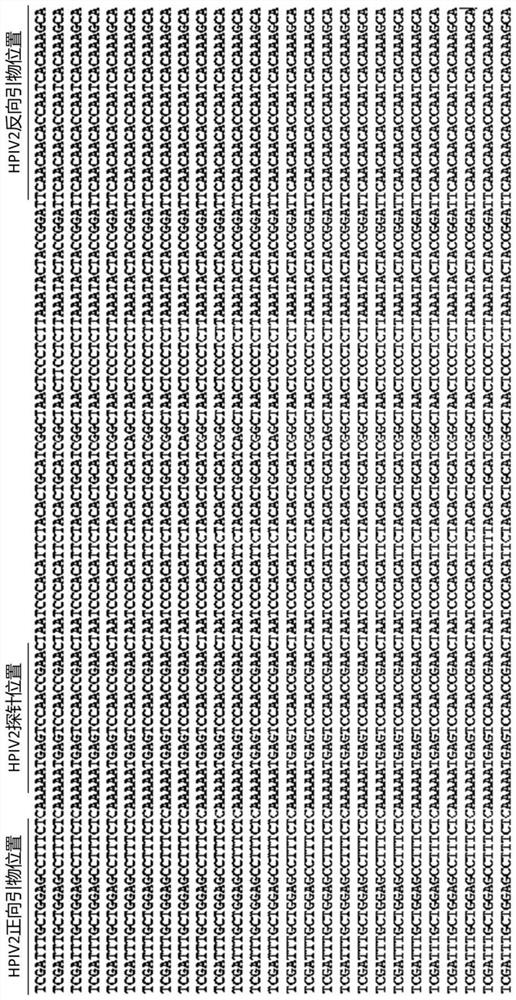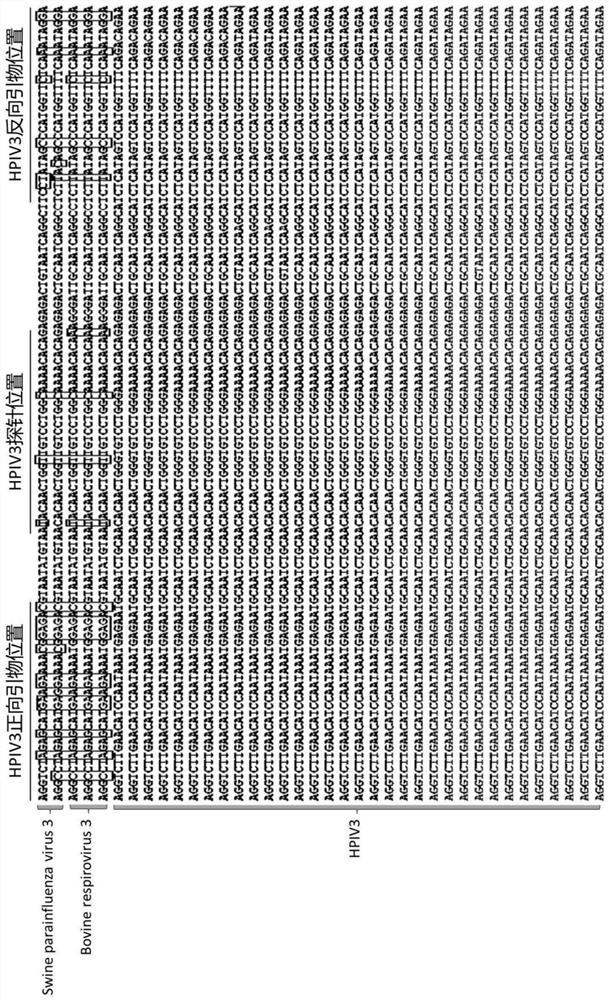Oligonucleotide mixture, fluorescent RT-PCR (Reverse Transcription-Polymerase Chain Reaction) detection reagent and application
An RT-PCR, oligonucleotide technology, applied in the field of pathogenic microorganism detection, can solve the problem of large missed detection risk, and achieve the effect of ensuring accuracy, preventing false positive results, and good inclusiveness
- Summary
- Abstract
- Description
- Claims
- Application Information
AI Technical Summary
Problems solved by technology
Method used
Image
Examples
Embodiment 1
[0052] Embodiment 1: This embodiment provides a design scheme of fluorescent RT-PCR primers and probes for detecting HPIV1-3 and human RNase P nucleic acid.
[0053] The primers and probes involved in the present invention are designed and screened according to the following principles:
[0054] (1) The positions of primers and probes are selected in the conserved sequence region of the target genome to reduce missed detection (false negatives), and this region must be exclusive to other organisms to avoid false positives (non-specific amplification).
[0055] (2) The distance between the 5' end of the probe and its upstream primer is no more than 30 bp, preferably no more than 10 bp, so as to ensure efficient cutting of the probe by Taq DNA polymerase to generate a fluorescent signal.
[0056] (3) The GC content is 30-80%; the Tm value of the primer is about 58-60°C, and the Tm value of the probe is about 68-70°C. The Tm difference between the forward and reverse primers sho...
Embodiment 2
[0070] Example 2: This example demonstrates that the fluorescent RT-PCR detection reagent of the present invention is made into a freeze-dried reagent by vacuum freeze-drying technology.
[0071] Prepare fluorescent RT-PCR liquid detection reagents according to the ingredients and contents described in Table 2 (primers and probes in the ingredients are prepared according to Example 1), and the reagents are divided into 200 μl PCR eight-connected tubes according to 1 part / tube and then carried out Vacuum freeze-drying, the obtained lyophilized fluorescent RT-PCR detection reagent is white particles ( Figure 5 ). Add 23 μl of nuclease-free water to a reagent, shake slowly for 10 seconds, the reagent is completely dissolved, and the volume measured with a pipette is 25 μl, which shows that the volume of the dry matter of the reagent before reconstitution is equivalent to 2 μl. In order to prevent the reagents from getting wet and exposed, the reagents are first vacuum-treated w...
Embodiment 3
[0072] Example 3: This example demonstrates the detection effect of the freeze-dried fluorescent RT-PCR detection reagent of the present invention on HPIV1-3 and human RNase P nucleic acid positive reference products.
[0073]For HPIV1-3 and human RNase P RNA positive reference substance mixture, perform 10-fold serial dilution, mix 5 μl and 18 μl nuclease-free water for each concentration, and then add to 1 part of lyophilized fluorescent RT- In the PCR detection reagent; 23 μl of nuclease-free water was used as a negative control substance. A reaction mixture with a volume of 25 μl was obtained, which was dissolved by slow shaking, centrifuged, and tested on a fluorescent PCR instrument. The reaction program was set according to Table 3. Do 2 repetitions for each treatment.
[0074] Test results such as Image 6 As shown, the detection results of the lyophilized fluorescent RT-PCR detection reagent of the present invention are all positive to no less than 5 copies of HPIV1...
PUM
| Property | Measurement | Unit |
|---|---|---|
| Volume | aaaaa | aaaaa |
| Volume | aaaaa | aaaaa |
Abstract
Description
Claims
Application Information
 Login to View More
Login to View More - R&D
- Intellectual Property
- Life Sciences
- Materials
- Tech Scout
- Unparalleled Data Quality
- Higher Quality Content
- 60% Fewer Hallucinations
Browse by: Latest US Patents, China's latest patents, Technical Efficacy Thesaurus, Application Domain, Technology Topic, Popular Technical Reports.
© 2025 PatSnap. All rights reserved.Legal|Privacy policy|Modern Slavery Act Transparency Statement|Sitemap|About US| Contact US: help@patsnap.com



